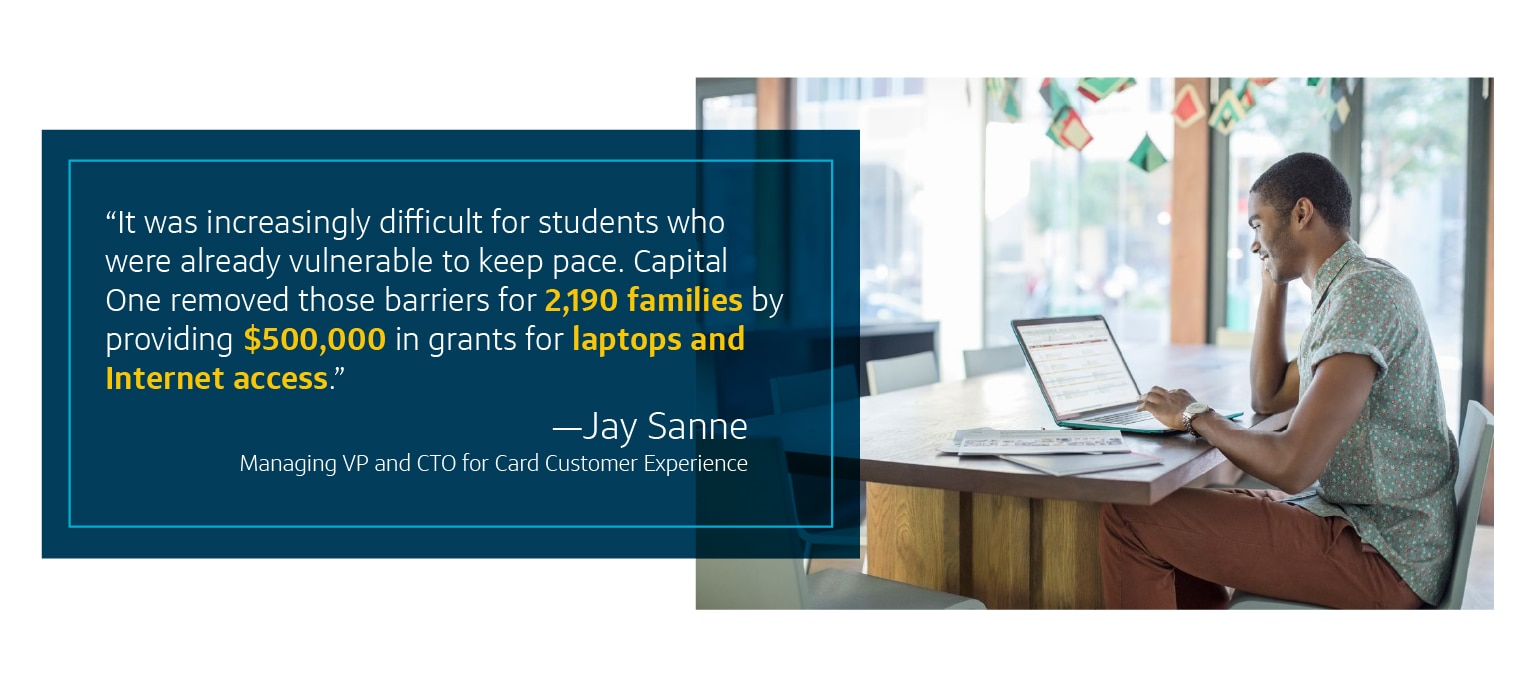Perspectives: Mentoring the Next Generation of STEM Stars
Mentoring programs like Capital One Coders enables digital learning for tomorrow’s leaders
With 2020 in the rearview mirror, many of us are looking toward a future bright with possibilities. The same holds true for the Capital One Coders, an initiative composed of nearly 6,000 Capital One associates around the country who have spent more than 110,000 volunteer hours teaching the next generation of tech leaders how to code.
Armed with software development basics, more than 19,000 U.S. students have gone through hands-on exploration of mobile app development, web design, and other emerging technologies, while learning computational thinking, a critical element in designing software. Our mission is to inspire these coders by educating, mentoring, and empowering them to recognize their potential as technologists.
At its core, STEM is a curriculum based on the foundation of teaching students in four disciplines – science, technology, engineering and mathematics – in an interdisciplinary and applied approach that emphasizes creativity, innovation, and problem-solving. Students studying with Capital One Coders, for example, can design an app that translates English to Spanish or develop a finger painting app that lets users draw digitally. Across 24 states, only 35% percent of U.S. high schools teach computer science, yet, computer-related jobs make up nearly 45% of STEM employment. Programs like Capital One Coders helps close that looming digital divide by giving students exposure to new career opportunities.

In honor of National Mentoring Month, an annual social observance recognized each January to celebrate mentorship, we spoke to Jay Sanne, Managing Vice President and Chief Technology Officer for Card Customer Experience. Sanne shares his thoughts on how the mentors and mentees of Coders adapted during the pandemic and on the company’s commitment to creating STEM stars.
Breaking Down Barriers
As the world went virtual last Spring, digital access was a roadblock to student success. “It was increasingly difficult for students who were already vulnerable to keep pace,” says Sanne. Capital One removed those barriers to “STEM education for 2,190 families by providing $500,000 in grants for laptops and Internet access, tangibly supporting the next generation with the tools they need to succeed.”
Innovating in a Virtual World
The virtual world gives Coders tremendous flexibility in how they reach and connect with students. Sanne says that going virtual allows the program to “inspire thousands more students and continue innovating in this space.” They are tinkering with the idea of implementing virtual curriculums like cybersecurity and artificial intelligence, and expanding their reach beyond the classroom through videos and large-scale workshops.
Teaching New Skills
While they haven’t been working alongside the students in person, the mentors are still inspiring students to recognize their potential. “Our virtual programs are teaching students new technology topics like web development, app development, and Python basics in addition to Capital One technologies,” says Sanne. His career trajectory shifted 25 years ago after a tech firm in Washington, D.C., hired him right out of undergraduate college. “Rather than giving students answers to remember, Coders gives them problems to solve.” As a result, students develop greater confidence in computer science as they explore technology virtually.

Mentoring Meaningfully
Beyond giving participants a fun, stimulating space to learn and interact with each other, the Coders program kept associates engaged during a very challenging time. These professionals teach students coding basics such as syntax, variables, conditional statements, arrays, loops, and testing. “The opportunity to mentor students provided a sense of belonging and purpose,” says Sanne. “Whether students are creating an app, designing a website, or building a bot through Coders, we give them the confidence to see themselves as technologists.” In other words, they are active participants in shaping their futures.
Making STEM Accessible
In science, girls perform similarly to boys and enroll in advanced science and math courses at the same rate as they enter high school. A gender gap occurs as girls take fewer of the more advanced STEM courses the closer they get to college. “In the popular imagination, men have often been associated with computer science expertise and skills, although, historically, women have been prominent leaders in the field,” Sanne explains. “By connecting coding concepts to real-life issues, you make it a universal language that speaks to all students, regardless of gender.”

Opening Doors
Last fall, one of the guardians of the earliest participants in the Coders program offered an update. A mother shared that her son is now pursuing a degree in computer science at the University of Virginia. To see such a tangible example of the program’s success is heartwarming for Sanne. “Early inspiration from Capital One Coders is defining his career trajectory,” he says. “Through Coders, we can have a lifelong influence on students’ future careers and aspirations.”


